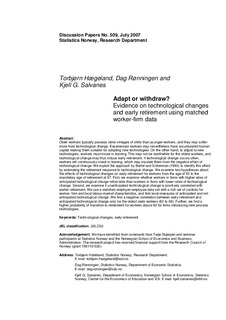Adapt or withdraw? Evidence on technological changes and early retirement using matched worker-firm data
Working paper

Åpne
Permanent lenke
http://hdl.handle.net/11250/180279Utgivelsesdato
2007Metadata
Vis full innførselSamlinger
- Discussion Papers [1003]
Sammendrag
Abstract:
Older workers typically possess older vintages of skills than younger workers, and they may suffer
more from technological change. Experienced workers may nevertheless have accumulated human
capital making them suitable for adopting new technologies. On the other hand, to adjust to new
technologies, workers must invest in training. This may not be worthwhile for the oldest workers, and
technological change may thus induce early retirement. If technological change occurs often,
workers will continuously invest in training, which may insulate them from the negative effect of
technological change. We exploit the approach by Bartel and Sicherman (1993) to identify this effect
by estimating the retirement response to technological change. We examine two hypotheses about
the effects of technological changes on early retirement for workers from the age of 50 to the
mandatory age of retirement at 67. First, we examine whether workers in firms with higher rates of
anticipated technological change retire later than workers in firms with lower rates of technological
change. Second, we examine if unanticipated technological change is positively correlated with
earlier retirement. We use a matched employer-employee data set with a rich set of controls for
worker, firm and local labour market characteristics, and firm level measures of anticipated and notanticipated
technological change. We find a negative correlation between early retirement and
anticipated technological change only for the oldest male workers (62 to 66). Further, we find a
higher probability of transition to retirement for workers above 60 for firms introducing new process
technologies.